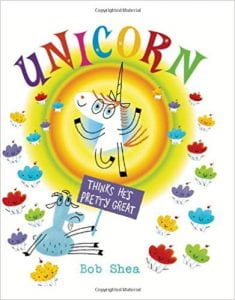Today’s post features books that can help foster an inclusive mindset in the classroom. If, as Rudine Sims Bishop tells us, books are meant to serve as windows as well as mirrors, we must share titles that offer our children a glimpse of people who are unlike themselves. I’ve already shared the book The Day You Begin in a previous post, and here are some more titles that I particularly like for building community:
Books to Appreciate Our Differences
 Unicorn Thinks He’s Pretty Great by Bob Shea
Unicorn Thinks He’s Pretty Great by Bob Shea
What starts off as Goat’s envy of the new kid — aka Unicorn — and all his fancy dance moves, cupcake conjuring, and general showing off, ultimately turns into appreciation once Unicorn shares all his problems along with the things he admires about Goat. By the end of the book, the two realize that their differences make them an UNSTOPPABLE team.
Here’s the official trailer for the book:
 Wild About Us written by Karen Beaumont and illustrated by Janet Stevens
Wild About Us written by Karen Beaumont and illustrated by Janet Stevens
“We’re all a little bit different, and that’s the way we like it!” is the message of this cheerful story about a group of animals who have warts, long noses, spots, big behinds, and ears that stick out. No matter their size, shape, or color each animal is shown smiling and content with who he/she is. The large colorful illustrations and snappy colorful language make it a great read-aloud, and students can have a lively discussion afterwards about how each animal’s body type is suited to its habitat and lifestyle.
Bridge to Reading offers an activity guide for the book, and Love to Learn offers a printable activity.
Books to Build Our Community
 A Bus Called Heaven by Bob Graham
A Bus Called Heaven by Bob Graham
The abandoned bus provides a gathering place on Stella’s street as everyone contributes to making it a welcoming place for the families in the neighborhood. And while this book emphasizes the importance of the whole group coming together, it also highlights how just one person can make a difference for the entire community. Graham does such a wonderful job of conveying empathy in his writing, and children will want one-on-one time with this book so they can fully appreciate all the small details in his illustrations.
Candlewick Press offers a guide of Classroom Ideas for using the book with students.
This window display at The Children’s Bookshop might inspire a makerspace project!
 Stone Soup retold by Heather Forest and illustrated by Susan Gaber
Stone Soup retold by Heather Forest and illustrated by Susan Gaber
Two tired hungry travelers arrive in a mountain town, only to find themselves turned away from every door and told the household has no food. It’s not until the clever men offer to make their “magic soup from a stone” that the townspeople come together and share their vegetables and seasonings. There are many good versions of this folktale available, but I like that in this one the author names the magical ingredient: sharing. There’s also a nice rhyming rhythm to the text that makes it a success as a read-aloud. There’s a recipe for stone soup on the last page, and the ingredient list includes one large stockpot, one stone the size of an egg, and a group of friends.
August House offers a guide for the book with some vegetable riddles, assessment questions, and follow-up activities.
 The Big Umbrella by Amy June Bates and Juniper Bates
The Big Umbrella by Amy June Bates and Juniper Bates
The anthropomorphic red umbrella in this story stretches to accommodate all those who seek its shelter. The lovely message of inclusion and acceptance is presented in simple sentences and allows teachers to sneak in a lesson about personification as well. Students will be interested to learn that the book is authored by a mother-daughter team, and the daughter was only in 6th grade when it was written.
Simon and Schuster offer a set of printable activity sheets for the book.
Listen to Amy and Juniper discuss how the book came about:
Do you have additional resources or ideas for using these books? Do you have other favorite books about diversity and inclusion that you share with your students? Please tell us about them in the comments!







